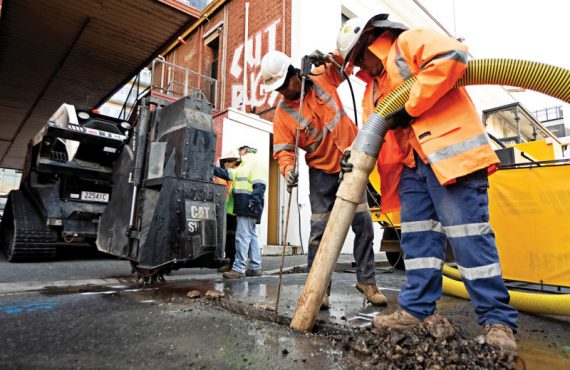Excavation is an essential part of construction and infrastructure projects. Whether for laying pipes, cables, or conducting maintenance work, digging is often required to reach underground utilities or create a foundation. Traditional digging methods can be risky, disruptive, and damaging to the surrounding environment. Enter non-destructive digging (NDD), a safe, efficient, and environmentally friendly alternative to conventional excavation techniques.
In Sydney, where underground infrastructure is dense and often delicate, non-destructive digging has emerged as a preferred method for excavation. But what exactly is non-destructive digging, and how does it work? This article highlights the benefits of NDD, how it works, and why it’s the go-to option for many drilling companies in NSW.
What is Non-Destructive Digging?
Non-destructive digging (NDD) is an excavation technique that uses high-pressure water or air to safely remove soil and debris from the ground without damaging underground utilities, structures, or the surrounding environment. This method is also known as hydro excavation or vacuum excavation, depending on the technology used.
The difference between NDD and traditional digging methods is the lack of heavy machinery or tools that can potentially damage pipes, cables, or other underground assets. With NDD, high-pressure water or air is used to break up the soil, which is then sucked into a vacuum tank for disposal. This process allows for precise and controlled excavation, making it ideal for working around sensitive underground utilities.
How Does Non-Destructive Digging Work?
Non-destructive digging works by using a combination of pressurised water or air, suction, and a vacuum tank to remove soil.
- Injection of High-Pressure Water or Air
The NDD process begins with the injection of high-pressure water or compressed air into the soil. The water or air loosens and breaks up the earth, making it easier to remove. The choice between water and air depends on the specific project needs. Water is used for softer soils, while air may be preferred for drier or compacted soils.
- Soil and Debris Removal
Once the soil is loosened, the excavation crew uses a vacuum hose to suck up the broken soil, water, and debris. The vacuum system transports the material into a holding tank, where it is safely stored for later disposal or reuse. This process ensures that the excavation site remains clean and no waste or soil is left behind.
- Precise Excavation Around Utilities
With traditional digging methods, the risk of damaging underground utilities is always present. With NDD, the excavation process can be precisely controlled. The high-pressure water or air is directed only where it’s needed, which allows workers to excavate safely around critical underground infrastructure, such as gas, water, and electrical lines.
This precise control makes NDD valuable in Sydney, where utility networks are dense and difficult to navigate. For drilling companies in NSW, NDD provides a way to safely excavate in areas where conventional methods would pose a significant risk of damage.
Why Choose Non-Destructive Digging?
Non-destructive digging offers several advantages over traditional excavation techniques. Let’s look at some of the key reasons why this method is gaining popularity in Sydney.
- Safety
The most significant benefit of non-destructive digging is the increased safety it provides. Traditional excavation methods involve large machines and manual labour, both of which can pose risks to workers and the surrounding area. Heavy machinery can accidentally strike underground utilities, leading to dangerous leaks or service disruptions. NDD eliminates this risk by using precise, controlled excavation techniques, which reduces the chances of damaging underground infrastructure.
- Minimal Disruption
In Sydney, traditional digging can cause significant disruptions. Roads are closed, traffic is rerouted, and businesses may suffer due to construction noise and surface damage. Non-destructive digging requires minimal surface disruption. The process only involves digging small pits at the beginning and end of the excavation path, and because the vacuum system is used to remove the soil, the area remains clean and tidy throughout the process.
- Versatility
Non-destructive digging is versatile and can be used for a wide range of applications. It’s ideal for installing or repairing utilities, such as water, gas, and electrical lines, and it’s also frequently used for telecommunications and fibre optic cable installations. The precision and safety offered by NDD make it the go-to method for various industries, including construction, civil engineering, and municipal works.
The Growing Popularity of Non-Destructive Digging in Sydney and NSW
In Sydney, underground infrastructure is dense and complex, non-destructive digging is becoming the go-to method for excavation. Drilling companies in NSW are increasingly adopting this technology to complete projects faster, safer, and more efficiently.
By offering a safe, efficient, and environmentally friendly way to excavate, non-destructive digging is quickly establishing itself as the preferred method of choice for modern construction projects.
- Conclusion
Non-destructive digging is revolutionising the way to approach excavation. It offers a range of benefits, including enhanced safety, minimal disruption, environmental protection, and cost savings. Whether working in Sydney or tackling complex infrastructure projects, non-destructive digging in Sydney provides a safe, efficient, and precise solution. For drilling companies in NSW, NDD offers a more reliable and sustainable way to complete underground excavation, making it the future of excavation in the region.





